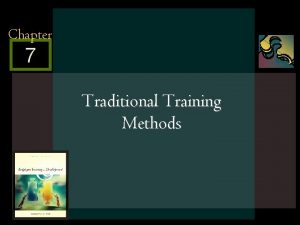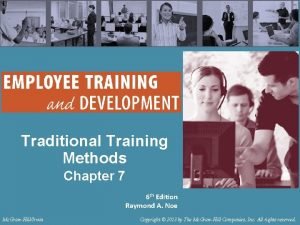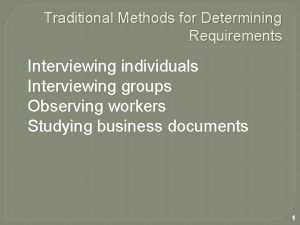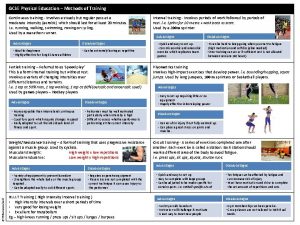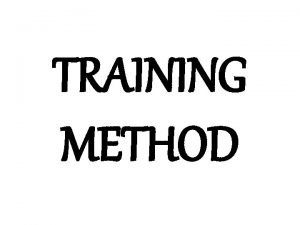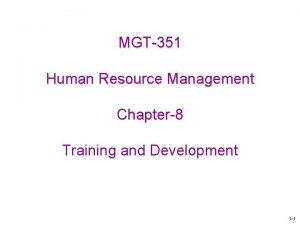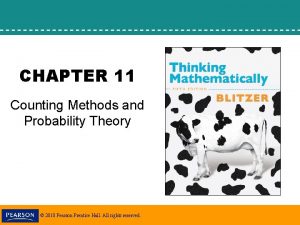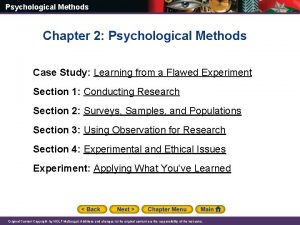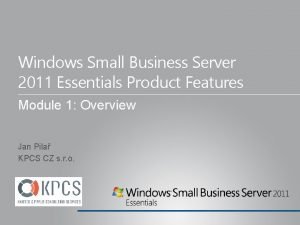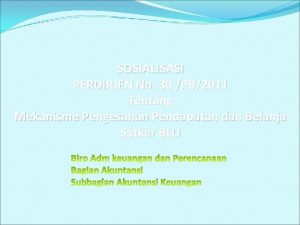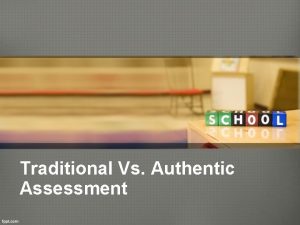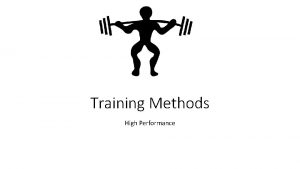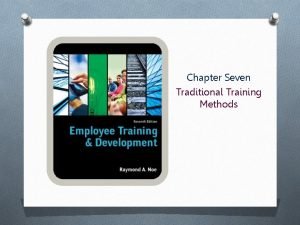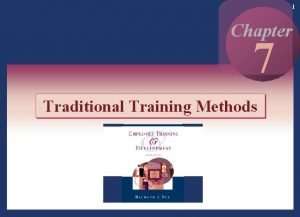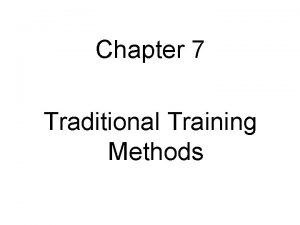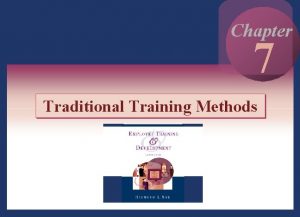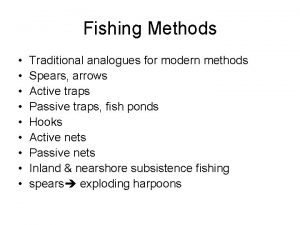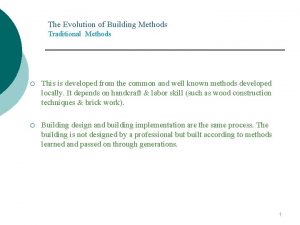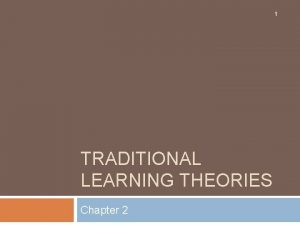Chapter 4 Traditional Training Methods Mc GrawHillIrwin 2011

































- Slides: 33

Chapter 4 Traditional Training Methods Mc. Graw-Hill/Irwin © 2011 The Mc. Graw-Hill Companies, Inc. All rights reserved. 4 -1

Chapter Objectives • After finishing this chapter, all students will be able: 1. Identify the presentation methods 2. Describe the hands-on methods 3. Explain the selection of training methods Mc. Graw-Hill/Irwin © 2011 The Mc. Graw-Hill Companies, Inc. All rights reserved. 4 -2

Introduction • The traditional training methods discussed in this chapter are organized into: presentation methods and hands-on methods. • The following sections provide a description of each method, a discussion of its advantages and disadvantages. Mc. Graw-Hill/Irwin © 2011 The Mc. Graw-Hill Companies, Inc. All rights reserved. 4 -3

Presentation Methods • Presentation methods are methods in which trainees are passive recipient of information. – Lectures and audiovisual techniques are presentation methods. – It is important to note that instructor-led classroom presentation methods may include lectures, video, workbooks, CD-ROMs and games. – That is, a mix of methods can actively engage trainees in learning. Mc. Graw-Hill/Irwin © 2011 The Mc. Graw-Hill Companies, Inc. All rights reserved. 4 -4

Presentation Methods (Cont’d) • Lecture – In a lecture, trainers communicate thru spoken words what they want the trainees to learn. – The communication of learned capacities is primarily one-way—from the trainer to the audience. – Instructor-led classroom presentation remains a popular training method despite new technologies such as interactive video and computer assisted instruction. Mc. Graw-Hill/Irwin © 2011 The Mc. Graw-Hill Companies, Inc. All rights reserved. 4 -5

Presentation Methods (Cont’d) • Lecture – Advantages • Least expensive and least time-consuming ways to present a large amount of information efficiently. • The lecture format is also useful because it is easily employed with large groups of trainees Mc. Graw-Hill/Irwin © 2011 The Mc. Graw-Hill Companies, Inc. All rights reserved. 4 -6

Presentation Methods (Cont’d) • Lecture – Disadvantages • Lectures tend to lack participant involvement, feedback, and meaningful connection to the work environment. • Lectures appeal to few of the trainees’ sense because trainees focus primarily on hearing information. • Lectures also make it difficult for the trainer to judge quickly and efficiently the learners’ level of understanding. • It can make to be bored to trainees if usage of long time. Mc. Graw-Hill/Irwin © 2011 The Mc. Graw-Hill Companies, Inc. All rights reserved. 4 -7

Presentation Methods (Cont’d) • Lecture – To overcome these problems, the lecture is often supplemented with question-and-answer periods, discussion, video, games, or case studies. – These techniques allow the trainer to build into the lecture more active participation, job-related examples, and exercise. Mc. Graw-Hill/Irwin © 2011 The Mc. Graw-Hill Companies, Inc. All rights reserved. 4 -8

Presentation Methods (Cont’d) • Audiovisual Techniques – Audiovisual instruction includes overheads, slides, and video. • Video is a popular instructional method. • Video is, however, rarely used alone. • It is usually used in conjunction with lectures to show trainees real-life experiences and example. Mc. Graw-Hill/Irwin © 2011 The Mc. Graw-Hill Companies, Inc. All rights reserved. 4 -9

Presentation Methods (Cont’d) • Audiovisual Techniques – Advantages • First, trainer can review; slow down, o speed up the lesson, which gives them flexibility. • Second, trainees can watch the video multiple times if they have access to it during and after the training session. • Third, trainees can be exposed to equipment, problems, and events that cannot be easily demonstrated Mc. Graw-Hill/Irwin © 2011 The Mc. Graw-Hill Companies, Inc. All rights reserved. 4 -10

Presentation Methods (Cont’d) • Audiovisual Techniques – Advantages • Fourth, trainees are provided with consistent instruction (realistic). • Fifth, videotaping trainees allows them to see and hear their own performance without the interpretation of the trainer. – Disadvantages • Too much content for the trainee to learn. • Drama that makes it confusing for the trainee to understand the important learning points emphasized in the video. Mc. Graw-Hill/Irwin © 2011 The Mc. Graw-Hill Companies, Inc. All rights reserved. 4 -11

Hands-on Methods • Hands-on method are training methods that require the trainee to be actively involved in learning. • These methods include: – – – – On-job training Group discussion Simulation Case studies Role plays and Behavior modeling Brainstorming Mc. Graw-Hill/Irwin © 2011 The Mc. Graw-Hill Companies, Inc. All rights reserved. 4 -12

Hands-on Methods (Cont’d) • On-the-Job Training (OJT) – Refers to new or inexperienced employees learning in the work setting and during by observing peer or managers performing the job and trying to imitate their behavior. • OJT is one of the oldest and most used types of informal training. • OJT can useful for training newly hired employees, upgrading experience employees’ skill when new technology is introduced. Mc. Graw-Hill/Irwin © 2011 The Mc. Graw-Hill Companies, Inc. All rights reserved. 4 -13

Hands-on Methods (Cont’d) • On-the-Job Training (OJT) – Advantages • It can be customized to the experiences and abilities of employees because OJT occurs on the job using actual tools and equipment. • Both trainees and trainers are at the job site and continue to work while training occurs. • This means that companies save the costs related to hiring trainers, and renting facilities. Mc. Graw-Hill/Irwin © 2011 The Mc. Graw-Hill Companies, Inc. All rights reserved. 4 -14

Hands-on Methods (Cont’d) • On-the-Job Training (OJT) – Advantages • OJT can be offered at any time, and trainers will be available because they are peers or managers. • OJT uses actual job tasks and occurs at work. As a result, skills learned in OJT more easily transfer to the job. Mc. Graw-Hill/Irwin © 2011 The Mc. Graw-Hill Companies, Inc. All rights reserved. 4 -15

Hands-on Methods (Cont’d) • On-the-Job Training (OJT) – Disadvantages • It is unstructured approach to OJT can result in poorly trained employees. • Managers and peers may not use the same process to complete a task. • They may pass on bad habits as well as useful skills. Mc. Graw-Hill/Irwin © 2011 The Mc. Graw-Hill Companies, Inc. All rights reserved. 4 -16

Hands-on Methods (Cont’d) • Group Discussion – It is a method which helps an individual to learn about a subject through interpersonal exchange of information and ideas in a group situation, whereby ten or twelve persons participate. – The method involves the group in active thinking process, which stimulates critical thinking amongst the members of the group. Mc. Graw-Hill/Irwin © 2011 The Mc. Graw-Hill Companies, Inc. All rights reserved. 4 -17

Hands-on Methods (Cont’d) • Group Discussion – Advantages • Learner-centered and subject-centered • Stimulates learners to think about problems or issues. • Encourage learners to exchanges their own experiences, thereby making learning more active. • Provide the opportunity for sharing of ideas and concerns. Mc. Graw-Hill/Irwin © 2011 The Mc. Graw-Hill Companies, Inc. All rights reserved. 4 -18

Hands-on Methods (Cont’d) • Group Discussion – Disadvantages • One number of the group can dominate the discussion. • Easy to digress the topic. • Shy learners may refuse to become involved or may need a great deal of encourage to participate. • More time consuming for the transmission of information than other methods Mc. Graw-Hill/Irwin © 2011 The Mc. Graw-Hill Companies, Inc. All rights reserved. 4 -19

Hands-on Methods (Cont’d) • Simulation – A simulation is a training method that represents a real-life situation, with trainees’ decisions resulting in outcomes that mirror what would happen if they were on the job. – A common example of the use of simulates for training is flight simulators for pilot. Mc. Graw-Hill/Irwin © 2011 The Mc. Graw-Hill Companies, Inc. All rights reserved. 4 -20

Hands-on Methods (Cont’d) • Simulation – In implementing this method, there is three phases: • Introduction or explanation to trainees on he process of stimulation, for example, how to use of tools and other documents. • Simulation exercise: in this phase, trainer have role as controller without tell or intervention. • Feedback: trainer provide the result of trainee after doing exercise. Mc. Graw-Hill/Irwin © 2011 The Mc. Graw-Hill Companies, Inc. All rights reserved. 4 -21

Hands-on Methods (Cont’d) • Case Studies – The case method is a teaching approach that consists in presenting the trainees with a case, putting them in the role of a decision maker facing a problem. – Case study research excels at bringing us to an understanding of a complex issue or object and can extend experience or add strength to what is already known through previous research Mc. Graw-Hill/Irwin © 2011 The Mc. Graw-Hill Companies, Inc. All rights reserved. 4 -22

Hands-on Methods (Cont’d) • Case Studies – The use of this method has the advantage of an opportunity being given to the learners to participate in free, frank and informal discussions. – This method is of particular use when the target group is to be told about a field related problem and the way the solution has been made. – The disadvantage of the use of this method is that the interest of the target group is difficult to sustain unless the case study is meaningful and interesting. Mc. Graw-Hill/Irwin © 2011 The Mc. Graw-Hill Companies, Inc. All rights reserved. 4 -23

Hands-on Methods (Cont’d) • Role Plays – Have trainees act out characters assigned to them. – For role plays to be effective, trainers need to engage in several activities before, during, and after the role play. – Role plays differ from simulations on the basis of response choices available to the trainees, the level of detail of the situation given to trainees, and the outcomes of the trainees’ response. Mc. Graw-Hill/Irwin © 2011 The Mc. Graw-Hill Companies, Inc. All rights reserved. 4 -24

Hands-on Methods (Cont’d) • Role Plays – Advantages • Energizing activity / fun to do • Allows participants to contribute actively • Experiential learning is more powerful than instructions. • It is time efficient to encourage to find out the solutions with problems. Mc. Graw-Hill/Irwin © 2011 The Mc. Graw-Hill Companies, Inc. All rights reserved. 4 -25

Hands-on Methods (Cont’d) • Role Plays – Disadvantages • Participants may be too shy and reluctant • Participants can get too loose objectivity (if trainer properly prepare plan). • It uses time so long • This play need fewer trainees Mc. Graw-Hill/Irwin © 2011 The Mc. Graw-Hill Companies, Inc. All rights reserved. 4 -26

Hands-on Methods (Cont’d) • Behavior Modeling – Present trainees with a model who demonstrate key behaviors to replicate and provide trainees with the opportunity to practice the key behaviors. – Leaning occurs by: • Observation of behaviors demonstrated by a model. • Vicarious reinforcement—occurs when a trainee sees a model receiving reinforcement for using certain behavior. Mc. Graw-Hill/Irwin © 2011 The Mc. Graw-Hill Companies, Inc. All rights reserved. 4 -27

Hands-on Methods (Cont’d) • Behavior Modeling – Advantages • Gives trainees excellent examples to follow. • Shows connections between concepts, events, processes. • Trainees receive the observation skill • More interest to trainees – Disadvantages • Poorly organized or ineffective demos confuse trainees about concepts and processes. Mc. Graw-Hill/Irwin © 2011 The Mc. Graw-Hill Companies, Inc. All rights reserved. 4 -28

Hands-on Methods (Cont’d) • Brainstorming – Brainstorming encourages creativity and generates many ideas quickly. • It can be used for solving a specific problem, answering a question, introducing a new subject, and raising interest. – Most brainstorming sessions follow this procedure: • Introduce a question, problem, or topic both orally and in writing on chart paper. Mc. Graw-Hill/Irwin © 2011 The Mc. Graw-Hill Companies, Inc. All rights reserved. 4 -29

Hands-on Methods (Cont’d) • Brainstorming – Most brainstorming sessions follow this procedure: • Invite participants to respond with as many ideas or suggestions as possible, ideally in single words or short phrases. • Record every response on chart paper. • Explain that until the brainstorm is complete, no one may repeat or comment on any response. • Afterward, prioritize, analyze, or use the list to generate discussion or problem solving. Mc. Graw-Hill/Irwin © 2011 The Mc. Graw-Hill Companies, Inc. All rights reserved. 4 -30

Hands-on Methods (Cont’d) • Brainstorming – Advantages • Listening exercise that allows creative thinking for new ideas. • Encourages full participation because all ideas are equally recorded. – Disadvantages • Can be unfocused. • Needs to be limited to 5 - 7 minutes. • If not managed well, criticism and negative evaluation may occur. Mc. Graw-Hill/Irwin © 2011 The Mc. Graw-Hill Companies, Inc. All rights reserved. 4 -31

Selection of Training Methods • As a trainer or manager, you will likely be asked to choose a training method. Given the large number of training methods available to you, this task may seem difficult. • One way to choose a training method is to depend on: – Subject – Trainer Mc. Graw-Hill/Irwin © 2011 The Mc. Graw-Hill Companies, Inc. All rights reserved. 4 -32

Selection of Training Methods (Cont’d) • One way to choose a training method is to depend on: – Trainee (educational level, age and experience and social/ culture environment) – Learning environment – Time and material factors Mc. Graw-Hill/Irwin © 2011 The Mc. Graw-Hill Companies, Inc. All rights reserved. 4 -33
 Traditional training methods
Traditional training methods Traditional training methods
Traditional training methods Traditional method of fish preservation
Traditional method of fish preservation How can ngt be used for requirements determination?
How can ngt be used for requirements determination? Traditional methods of capital budgeting
Traditional methods of capital budgeting Indirect wax pattern
Indirect wax pattern Disadvantages of interval training gcse pe
Disadvantages of interval training gcse pe Circuit training methods
Circuit training methods 5 disadvantages of circuit training
5 disadvantages of circuit training Teletraining in hrm
Teletraining in hrm Methods of training
Methods of training Employee training methods
Employee training methods Methods of training
Methods of training Training is expensive without training it is more expensive
Training is expensive without training it is more expensive Metode of the job training
Metode of the job training Aggression replacement training facilitator training
Aggression replacement training facilitator training Chapter 19 methods of therapy
Chapter 19 methods of therapy Chapter 11 counting methods and probability theory answers
Chapter 11 counting methods and probability theory answers Single blind study
Single blind study Chapter 1 section 2 scientific methods answer key
Chapter 1 section 2 scientific methods answer key Psychology chapter 2 section 1
Psychology chapter 2 section 1 Research methods for business students chapter 5
Research methods for business students chapter 5 Wyd madrid 2011
Wyd madrid 2011 Small business server 2010
Small business server 2010 Small business server 2011 essentials
Small business server 2011 essentials Seitel public relations
Seitel public relations Enem 2011 uma equipe de cientistas
Enem 2011 uma equipe de cientistas Per-30/pb/2011
Per-30/pb/2011 Yevarejeja yahweh
Yevarejeja yahweh How did dorothea puente die
How did dorothea puente die Sage act 2011
Sage act 2011 Chemistry regents 2011
Chemistry regents 2011 2011-1989
2011-1989 Boardworks ltd 2011
Boardworks ltd 2011
